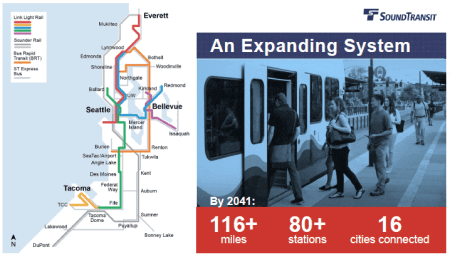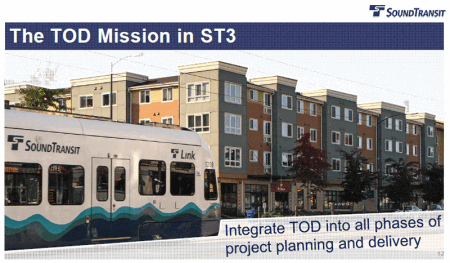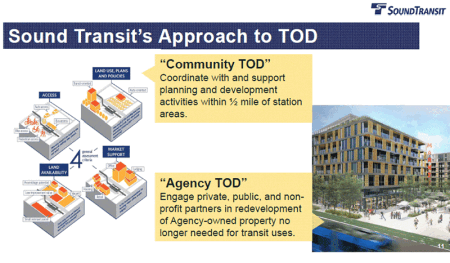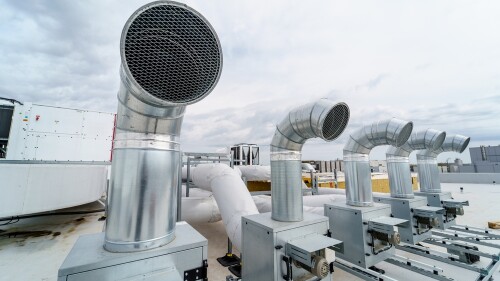When Sound Transit completes its third phase of expansion in 2041, Greater Seattle will be a region transformed. The transit agency currently operates a 20-mile (32 km) light-rail line through Seattle, a shorter line in Tacoma, commuter rail, and bus systems. The $54 billion Sound Transit 3 (ST3) package, approved by voters in November, will bring a total of 116 miles (187 km) of light rail connecting 80 stations in Everett, Seattle, Tacoma, and surrounding suburbs, plus bus rapid transit and more to serve a rapidly growing population.
That influx of new transit and people presents a huge opportunity for transit-oriented development (TOD). In March, ULI Northwest hosted a panel discussion of development experts focusing on what this transit investment will mean for further development and housing affordability, the political action necessary to capitalize on TOD, and how developers can start working now with Sound Transit and private landholders to be well positioned as new stations open over the next two decades.
“There are few times in our life that we know what we’re going to experience is going to be life changing,” said John Hempelmann, chairman of Cairncross & Hempelmann and ULI TOD Product Council chairman. “We haven’t had really high-capacity transit in the Seattle region that stimulates development around those high-capacity stations.”
In the past, TOD was somewhat of an afterthought for Sound Transit, as evidenced in the small, difficult-to-develop parcels of surplus land it bought near stations for staging during the first phase of light-rail construction. With ST3, the agency has a mandate from its board to think strategically about surplus land and TOD. To that end, the agency created the position of TOD director and placed longtime Sound Transit staffer Brook Belman in the role.
In granting Sound Transit permission to put ST3 to a vote last November, the state legislature stipulated that surplus land must be offered first to housing authorities and nonprofit developers and that 80 percent of the units built on surplus land must be affordable to households earning less than 80 percent of the area median income.
“I think everyone in the room would agree one of the biggest issues facing our state is affordable housing,” said Ric Ilgenfritz, Sound Transit executive director of planning, environment, and project development. “We want to challenge you to think about how we can work together to make affordability work. Partnerships will be key to making things happen.”
Ilgenfritz pointed to the recently opened Capitol Hill station as an example of how the agency see partnerships working on surplus land TOD. Private developer Gerding Edlen is partnering with nonprofit housing provider Capitol Hill Housing on a four-building, 427-unit project around the station. More than 162 units will be leased at below market rate for 12 years and another 110 units, managed by Capitol Hill Housing, will be permanently affordable.
The land owned by Sound Transit represents just a fraction of the possibilities for TOD near future light-rail stations.
“There’s lots of other land around stations to develop at market rate. It’ll be important to think beyond Sound Transit–owned land to how development will work in the whole walkshed around stations,” said Peter Rogoff, Sound Transit chief executive officer. “If you think office space around transit stations is enticing now, just wait a few years when there are another million people in the region.”
Though the new stations are still decades from opening, Greg Johnson, president of Wright Runstad & Company, said now is the time to start building relationships with Sound Transit and private landowners. Wright Runstad is developing a 36-acre (14.5 ha), mixed-use project called the Spring District next to a future light-rail station in Bellevue. Though the station is not slated to open until 2023, Johnson started working on the project nearly ten years ago.
“Someone’s already put a dot on maps for every one of those planned stations that’ll open in 2026 or 2030. You can go out now and draw your quarter-mile radius, collect capital, and start building partnerships with local landowners,” said Johnson.
Though the panel’s focus was on the steps developers can take to move TOD forward, there was recognition that some elements—mostly political—beyond developer control could also shape things to come.
At the local level, developers need city councils to approve upzoning around new stations to maximize TOD potential. De’Sean Quinn, a city council member in Tukwila, shared his experience advocating for upzones in that city and getting pushback from the community.
“There are people who don’t want to see change,” he said. “But there are a lot more elected officials, a lot more city staff and planners willing to take the risk now than in the past. We’re pretty much built out in the single-family neighborhoods, so the next step is to build up.”
Federal politics also could influence TOD in the region. With federal budget proposals to eliminate future Federal Transit Administration grants fresh in people’s minds, an audience member asked what would happen to ST3. After all, it’s hard to build TOD if there’s no transit.
Ilgenfritz said about 15 percent of ST3 funding comes from federal money, and losing it would be a big hit. But he also reminded people that the budget proposal is just the starting place for budget negotiations and said Sound Transit is currently moving ahead on ST3 as planned.
Though the threat of lost funds looms large, Rogoff is confident at least that residents in the region have fully bought into the project and coming TOD.
“Voters have taken a bold step with ST3,” he said. “It’s not just a few cents they’re taxing themselves. The average adult is paying an additional $169 a year. They came in and asked for this broad buildout. It’s a market indicator very much worth listening to. The entire electorate has voted to demonstrate that they get it.”







